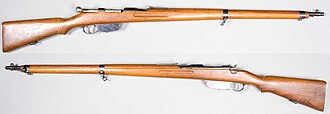| Mannlicher M1895 | |
|---|---|
 Mannlicher M1895 Rifle. From the collections of the Swedish Army Museum. | |
| Type | Straight pull bolt-action rifle |
| Place of origin | Austria-Hungary |
| Service history | |
| In service | 1895–1918 (Austria-Hungary) 1895–1949 (Other nations) |
| Used by | See Users |
| Wars | First Sino-Japanese War Boxer Rebellion Ilinden–Preobrazhenie Uprising First Balkan War Second Balkan War World War I Russian Civil War[1] Austro-Slovene conflict in Carinthia Revolutions and interventions in Hungary Polish-Soviet War Austrian Civil War Second Italo-Ethiopian War Spanish Civil War[2] Sudeten German uprising World War II Greek Civil War[3] 1948 Arab–Israeli War[3] 1958 Lebanon crisis Lebanese Civil War Rhodesian Bush War |
| Production history | |
| Designer | Ferdinand Mannlicher |
| Designed | 1895 |
| Manufacturer | 1896–1918: Œ.W.G. in Steyr 1897–1918: F.G.GY. in Budapest 1918–1920: Zbrojovka Brno |
| Produced | 1896–1920 |
| No. built | approx. 3,500,000[4] |
| Variants | See Variants |
| Specifications (M95 Long Rifle) | |
| Mass | Rifle: 3.78 kg (8.3 lb) Carbine: 3.4 kg (7.5 lb) |
| Length | Rifle: 1,272 mm (50.1 in) Carbine: 1,003 mm (39.5 in) |
| Barrel length | Rifle: 765 mm (30.1 in) Carbine: 500 mm (19.7 in) |
| Cartridge | M95: 8×50mmR Mannlicher M95/30 & 31.M: 8×56mmR M95/24 & M95M: 7.92×57mm Mauser |
| Action | Straight-pull bolt action |
| Rate of fire | approx. 20–25 rounds/min |
| Muzzle velocity | M93 (8×50mmR): 620 m/s (2,000 ft/s) M30 (8×56mmR): 720 m/s (2,400 ft/s) |
| Feed system | 5-round internal box magazine, loaded with 5-round en bloc clips or (stripper clips in M95/24 and M95M variants) |
| Sights | Rear V-notch flip-up sight and front post (telescopic sight on sniper variant) |
The Mannlicher M1895 (German: Infanterie Repetier-Gewehr M.95, Hungarian: Gyalogsági Ismétlő Puska M95; "Infantry Repeating-Rifle M95") is an Austro-Hungarian straight pull bolt-action rifle, designed by Ferdinand Ritter von Mannlicher that used a refined version of his revolutionary straight-pull action bolt, much like the Mannlicher M1890 carbine. It was nicknamed the Ruck-Zuck-[Gewehr] by Austrian troops (ruck-zuck spoken as "roock-tsoock", in common language meaning "back and forth [rifle]") and "Ta-Pum" by Italian troops who wrote a song (it) about it during World War I. The primary producers were the ŒWG in Steyr, and FÉG in Budapest.
Originally they were chambered for the round nosed 8×50mmR cartridge, but almost all of the rifles were rechambered to accept the more powerful and longer range spitzer 8×56mmR cartridge in the 1930s.
- ^ Scarlata, Paul (20 November 2014). "Russian rifles of the great war, revolution & civil war—part I". Shotgun News. Archived from the original on 27 September 2015. Retrieved 19 September 2015.
- ^ "spanishcivilwar1". Retrieved 10 October 2014.
- ^ a b "Moschetto M95 carbine postwar". wwiiafterwwii.wordpress.com. 20 May 2015.
- ^ John Walter (25 March 2006). Rifles of the World. Krause Publications. p. 265. ISBN 0-89689-241-7. Retrieved 9 September 2014.